- Home
- Quizzes
- My Quiz Activity
- Newsletters
- Sports Betting
- MY FAVORITES
- Add Sports/Teams
- SPORTS
-
NFL
- NFL Home
- Arizona Cardinals
- Atlanta Falcons
- Baltimore Ravens
- Buffalo Bills
- Carolina Panthers
- Chicago Bears
- Cincinnati Bengals
- Cleveland Browns
- Dallas Cowboys
- Denver Broncos
- Detroit Lions
- Green Bay Packers
- Houston Texans
- Indianapolis Colts
- Jacksonville Jaguars
- Kansas City Chiefs
- Las Vegas Raiders
- Los Angeles Chargers
- Los Angeles Rams
- Miami Dolphins
- Minnesota Vikings
- New England Patriots
- New Orleans Saints
- New York Jets
- New York Giants
- Philadelphia Eagles
- Pittsburgh Steelers
- San Francisco 49ers
- Seattle Seahawks
- Tampa Bay Buccaneers
- Tennessee Titans
- Washington Commanders
-
MLB
- MLB Home
- Arizona Diamondbacks
- Atlanta Braves
- Baltimore Orioles
- Boston Red Sox
- Chicago White Sox
- Chicago Cubs
- Cincinnati Reds
- Cleveland Guardians
- Colorado Rockies
- Detroit Tigers
- Houston Astros
- Kansas City Royals
- Los Angeles Angels
- Los Angeles Dodgers
- Miami Marlins
- Milwaukee Brewers
- Minnesota Twins
- New York Yankees
- New York Mets
- Oakland Athletics
- Philadelphia Phillies
- Pittsburgh Pirates
- San Diego Padres
- San Francisco Giants
- Seattle Mariners
- St. Louis Cardinals
- Tampa Bay Rays
- Texas Rangers
- Toronto Blue Jays
- Washington Nationals
-
NBA
- NBA Home
- Atlanta Hawks
- Boston Celtics
- Brooklyn Nets
- Charlotte Hornets
- Chicago Bulls
- Cleveland Cavaliers
- Dallas Mavericks
- Denver Nuggets
- Detroit Pistons
- Golden State Warriors
- Houston Rockets
- Indiana Pacers
- Los Angeles Clippers
- Los Angeles Lakers
- Memphis Grizzlies
- Miami Heat
- Milwaukee Bucks
- Minnesota Timberwolves
- New Orleans Pelicans
- New York Knicks
- Oklahoma City Thunder
- Orlando Magic
- Philadelphia 76ers
- Phoenix Suns
- Portland Trail Blazers
- Sacramento Kings
- San Antonio Spurs
- Toronto Raptors
- Utah Jazz
- Washington Wizards
-
NHL
- NHL Home
- Anaheim Ducks
- Arizona Coyotes
- Boston Bruins
- Buffalo Sabres
- Calgary Flames
- Carolina Hurricanes
- Chicago Blackhawks
- Colorado Avalanche
- Columbus Blue Jackets
- Dallas Stars
- Detroit Red Wings
- Edmonton Oilers
- Florida Panthers
- Los Angeles Kings
- Minnesota Wild
- Montreal Canadiens
- Nashville Predators
- New Jersey Devils
- New York Islanders
- New York Rangers
- Ottawa Senators
- Philadelphia Flyers
- Pittsburgh Penguins
- San Jose Sharks
- Seattle Kraken
- St. Louis Blues
- Tampa Bay Lightning
- Toronto Maple Leafs
- Vancouver Canucks
- Vegas Golden Knights
- Washington Capitals
- Winnipeg Jets
- NCAAF
- NCAAM
- Boxing
- Entertainment
- Lifestyle
- Golf
- MMA
- Soccer
- Tennis
- Wrestling
- More Sports
- RESOURCES
- My Account
- YB on Facebook
- YB on Twitter
- YB on Flipboard
- Contact Us
- Privacy Policy
- Terms of Service

Axe to grind: 25 famous guitars and their rock star owners
Ever since Chuck Berry hot-wired the "jump blues" sound in the 1950s, the electric guitar has been the soul of rock-and-roll. The plugged-in, amplified twang and squeal sounded like noise to adults, but for kids all over the world, it was the sound of rebellion. Sixty years later, "the axe" is still the defining instrument of the genre. Once mastered, it becomes more than just an instrument; it's like an old friend or a spouse. Over the years, certain guitars have taken on a mythic quality; in some cases, they're as coveted and beloved as the musicians who play them. Let's take a look back at some of the most iconic guitars to ever preach the gospel of rock.
B.B. King - "Lucille"
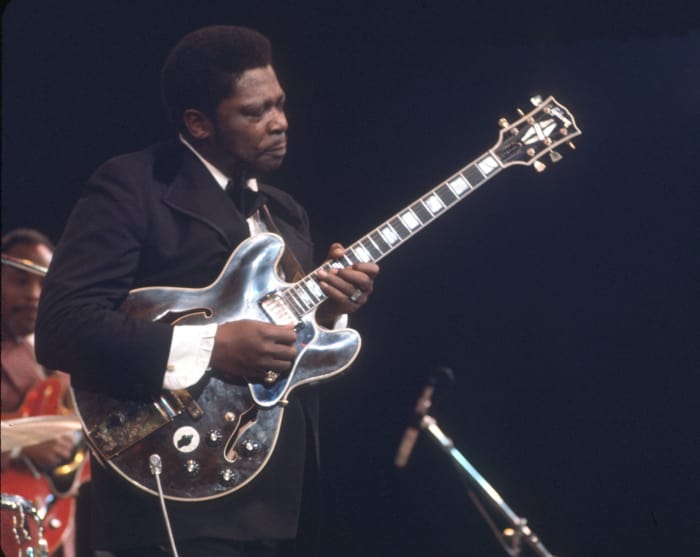
Ask any music fan to make a list of famous guitars, and they’ll likely start with B.B. King’s beloved Lucille. King’s old lady was a Gibson semi-hollow body ES-355, and she was named for a woman who, in a roundabout way, sparked a club fire that nearly claimed the musician’s life. King had safely escaped the conflagration, but when he realized he’d left his guitar inside, he rushed back into the collapsing establishment to rescue it. King ran through many Gibsons over the years, but each one bore the moniker "Lucille."
Eddie Van Halen - "Frankenstrat"

The ultimate ‘80s guitar hero started on an unmodified Ibanez Destroyer, but his signature axe is the fierce-sounding (and fearsome) Frankenstrat. It’s a custom-built, red-white-and-black monster that combines a Fender Stratocaster body with Gibson pickups and a Floyd Rose tremolo. At least, that’s how it started. The finicky Van Halen tweaked and upgraded the beast over the years, but the sound largely remained the same. A copy of the Frankenstrat is on display at the Smithsonian National Museum of Natural History.
Michael Schenker - Gibson Flying V
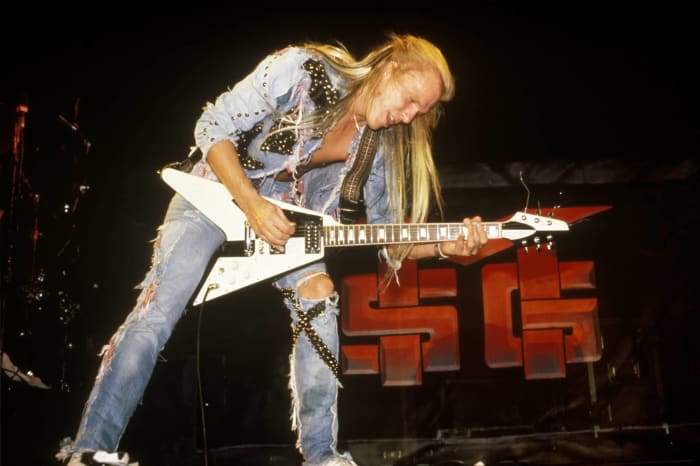
There have been several skilled shredders of the Gibson Flying V, but no one has ever played the instrument with more ferocity or panache than German metal god Michael Schenker. The brother of Scorpions lead guitarist Rudolf Schenker is best known for his hard-rocking 1970s run with UFO, during which he laid down a legendarily savage solo on the live recording of "Rock Bottom." James Hetfield and Kirk Hammett of Metallica are two notable devotees to the holy Flying V tone of Michael Schenker.
Jimi Hendrix - Fender Stratocaster
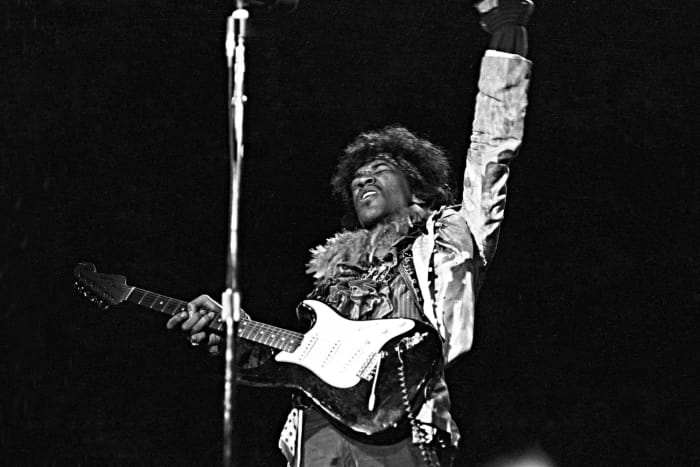
A right-handed Fender Stratocaster strung upside down for a left-handed mother-loving genius named Jimi Hendrix. There were great, celebrated guitarists prior to Hendrix, but none of them were worshipped as gods. Then again, none of them could play a Fender Strat backward, over their head or with their freaking teeth. And they damn sure never lit their instrument on fire after playing the show of their life at the Monterey Pop Festival in 1967. That’s where the Hendrix legend began. It’s impossible to strap one over your shoulder and not strike the opening three barre chords to "All Along the Watchtower."
Vernon Reid - ESP Mirage
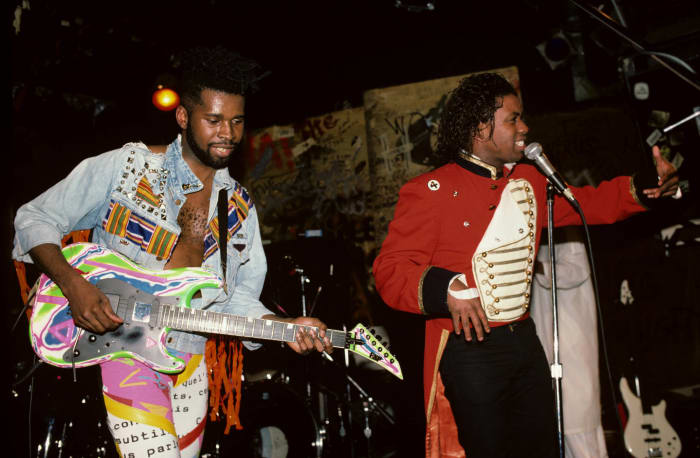
Living Colour shook the music industry out of its hair-metal stupor in the late 1980s with a hybrid funk-prog sound you could bang your head to. The band’s sizzling style was driven by the lightning-fingered fret wizardry of Vernon Reid, who gave Japanese guitar manufacturer ESP a huge promotional boost with his rainbow-colored ESP Mirage in the video for "Cult of Personality." They called him "Burnin’ Vernon" for his Hendrix-inspired solos, but Reid would be the first to tell you Funkadelic’s Eddie Hazel was every bit as influential.
Rick Nielsen - Five-Neck Hamer

The eccentric lead guitarist of Cheap Trick has played live with multiple axes slung over his shoulders, so why not have Hamer produce a custom-made five-necked monster for showman’s sake? Unless you have abnormally long arms, it’s not a practical instrument at all — at least not when you’re standing. But Nielsen is an avid guitar collector, and he loves Hamer’s instruments; if you can afford to have a top guitar manufacturer build you a five-necked guitar, you kinda have to do it.
Bo Diddley - "Twang Machine"
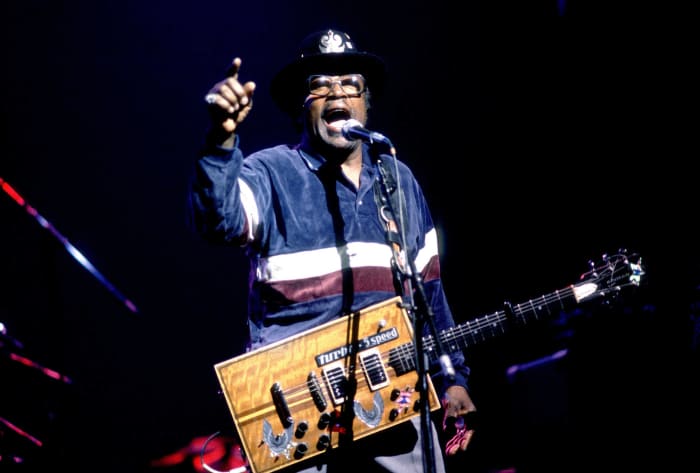
Bo Diddley is an American original. He introduced a new, syncopated sound to American popular music (now called the "Bo Diddley beat") and beat it all out on a cigar box-shaped guitar he called the "Twang Machine." Diddley built the instrument himself after an embarrassing stage accident that left him with an injured groin, and he stuck with it through the rest of his career. It isn't sexy, but it got the job done.
Prince - "Cloud"
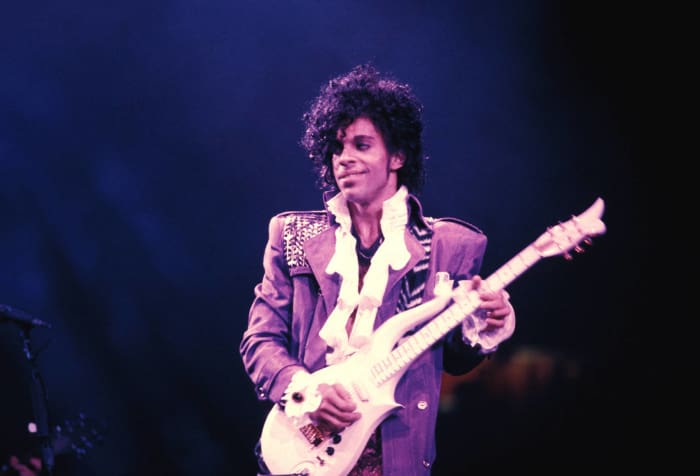
His Royal Badness started out on a Hohner MadCat Telecaster, but when he was prepping for his debut film, "Purple Rain," he wanted to play something that looked a little flashier and sexier and, well, a little more like Prince! He turned to Minneapolis luthier Dave Rusan, who took Prince’s design and built the guitar from scratch. Though Prince switched to the Symbol guitar in the early 1990s, the Cloud guitar is still the signature instrument with which he is associated. A yellow version is on display at the Smithsonian.
Gene Simmons - Axe Bass
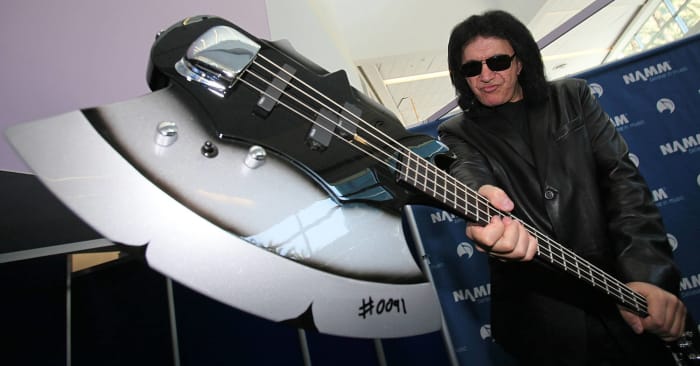
The "Knights in Satan’s Service" were all about horrifying theatrics, and no one in the band embodied or relished this more than bassist Gene Simmons. He had the coolest look and the coolest instrument by far. Legendary luthier Steve Carr built the first axe bass, and Simmons has stuck with the look (though not the exact bass) throughout his career.
Neil Young - "Old Black"
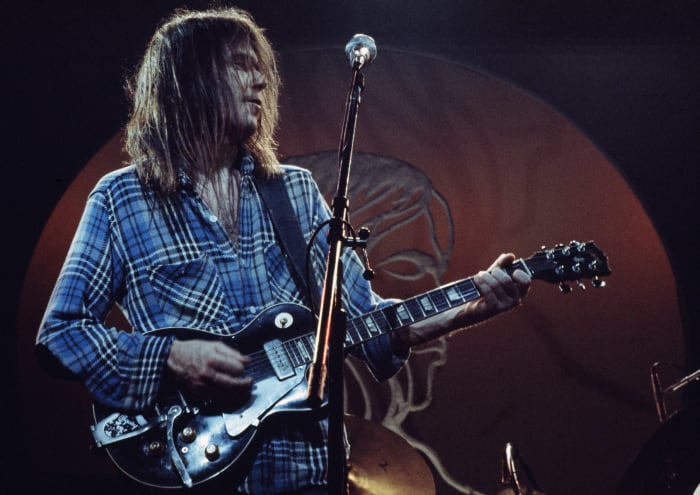
This classic 1953 Gibson Les Paul Goldtop has been Neil Young’s instrument of choice for almost 50 years. He acquired it in a trade with Buffalo Springfield’s Jim Messina, and he has played it on nearly every album since 1969’s "Everybody Knows This is Nowhere." Young has made some modifications over the years, and it has required a good deal of repair, but Old Black is still kicking out the jams all these years later.
Randy Rhoads - Polka Dot V

Randy Rhoads had two signature axes: the Jackson Rhoads "Concorde" and the Karl Sandoval "Polka Dot V." Both were variations on the classic Flying V look, and they both looked awesome when he played them. Which was more iconic? There’s no wrong answer here, but let’s go with the Polka Dot V, as that’s what Rhoads was playing when he recorded "Crazy Train" with Ozzy Osbourne.
Brian May - "Red Special"

This homemade classic can be heard on just about every classic Queen track. Brian May built the instrument from scratch with his father, using oak from an old table for the body and wood from a well-aged fireplace mantel. May always toured with the Red Special, and, after decades of abuse, had it restored in 1998. He upgraded it again in 2005, but 54 years after its construction, he has yet to retire the old beauty.
Tony Iommi - "Old Boy"
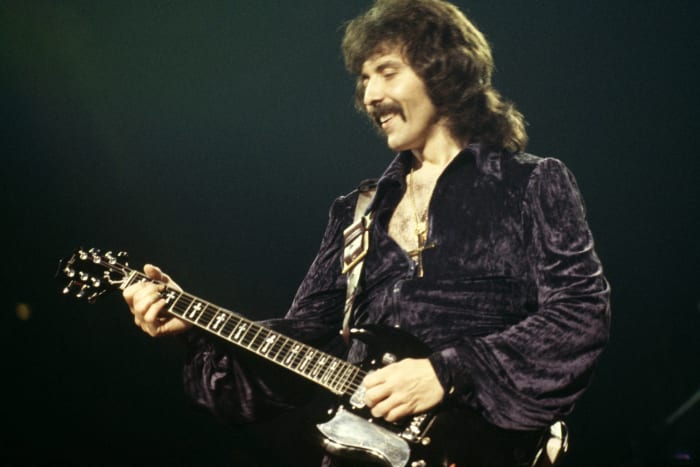
The JD Custom SG, aka "Old Boy," was built in 1975 by luthier John Diggins, and it can be heard on Black Sabbath LPs starting with "Heaven and Hell." It’s not Iommi’s main guitar (that would be the Gibson SG "Monkey"), but that faded red-and-black look (and the upside-down crosses on the fret board) are the first thing you think of when you hear Iommi soloing on any of Sabbath’s classics.
Keith Richards - "Micawber"
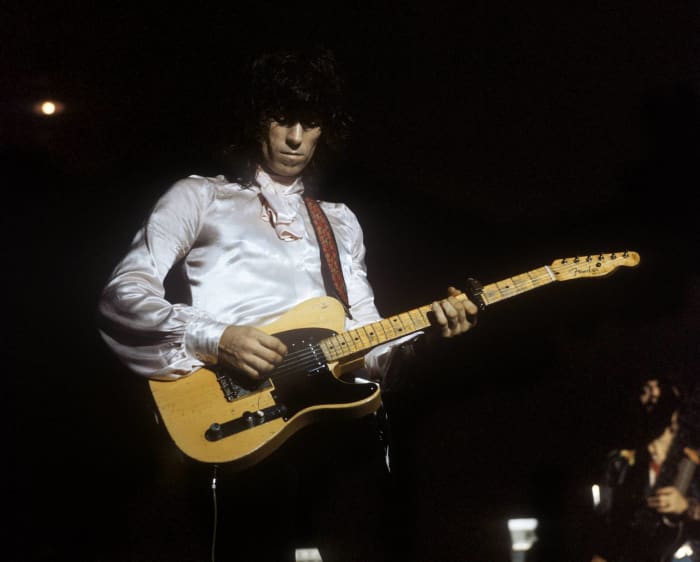
This weathered 1953 Fender Telecaster is named after Wilson Micawber, the debtor tormented by Uriah Heep in Charles Dickens’s "David Copperfield," but torment is not the emotion one typically associates with Keith Richards’s blues-inflected riffs. The Micawber has been producing boozy, after-hours sounds since debuting during the “Exile on Main St.” sessions, and it's often at Richards’s side on stage.
Angus Young - Jaydee SG

The Jaydee SG was crafted especially for AC/DC's tireless, head-banging lead guitarist, and it features lightning bolt inlays all down the fretboard. He’s since brought the design to Gibson, which replicated the look and sound to his liking, but it all started back (always in black) with the Jaydee.
Jimmy Page - Double-Neck Gibson SG

"Stairway to Heaven" has probably sold more guitars than any song in rock-and-roll history, but diehard Led Zeppelin fans know that if you want to play it like Jimmy Page played it live, there is no substitute for the Gibson double-necked EDS-1275. Page went with the instrument because it allowed him to play the entire song live without switching guitars: the bottom neck has six-strings for the opening, while the top brings the 12-string thunder for the furious climax.
ZZ Top - "Spinning Fur" Dean Z

ZZ Top generally favored Dean Zelinsky’s modified version of the Gibson Explorer, so when it came time to do something flashy for the music video "Legs," they asked the luthier to craft spinning versions covered in sheep’s wool. Zelinsky came through, and the band often brings out the furry instruments for live performances because every girl’s crazy about…guitars covered in sheep’s wool that can spin.
Eric Clapton - "Blackie"

After making his bones throughout the 1960s playing Gibson guitars, Clapton switched over to Fender Stratocasters in 1970 and has generally stuck with the model ever since. The first Strat was called "Brownie" and was used during the "Layla" sessions, but for live performances, Clapton went with "Blackie" (both imaginatively named for their color). Watch any Clapton concert from 1973 to 1985 and you’ll see "Blackie."
Paul McCartney - Höfner Violin Bass

The Höfner 500/1 Violin Bass was the instrument on which Paul McCartney played some of the greatest pop songs ever recorded. The left-handed musician bought his first Höfner in 1961 because he thought it would be easier for him to play, and he stuck with it throughout his entire Beatles career (though he did begin to work in a Rickenbacker and Fender after 1965). It’s a unique instrument that is exclusively associated with McCartney.
George Harrison - Rickenbacker 360/12

For the majority of his career, Harrison was a Stratocaster man, but the 12-string Rickenbacker 360/12 was his guitar for the "A Hard Day’s Night" sessions, and you can hear the difference. Adolph Rickenbacker gave Harrison the guitar in February 1964, and he was often photographed with it during the band’s 1964 U.S. tour. It’s an elegant-looking instrument.
Stevie Ray Vaughan - "1959 Strat"

Though Stevie Ray Vaughan’s signature axe sported a 1963 Fender body, the late blues rock guitarist referred to it as a "1959 Strat" due to its 1959 pickups, and no one who ever listened to the man tear it up ever argued the point. With the exception of Funkadelic’s Eddie Hazel, no one has gotten a more ferocious sound out of the Stratocaster since Jimi Hendrix. It’s a tragedy we lost SRV so damn early, too.
Pete Townshend - Gibson Les Paul Deluxe

There are few sights in rock-and-roll more iconic than Pete Townshend windmill-strumming his Gibson Les Paul Deluxe. He made a mostly permanent shift to Gibson guitars around the time of The Who’s performance at Woodstock, and he ran through quite a few of them due to his penchant for smashing them at the end of live shows. It might not be the ideal promotion for a line of guitars, but it certainly didn’t hurt Gibson’s sales.
Kurt Cobain - "Jag-Stang"

The left-handed Cobain was a fan of Fender guitars, particularly the Jaguar and the Mustang. When the band hit it big with "Nevermind," Cobain went to the guitar company with the idea for a hybrid called the Jag-Stang. While he did not record with the custom-built red-and-white instrument, he brought it with him for the "In Utero" tour in 1994 — and even then, he only played it sparingly. It could be that he never had the time to modify it to his liking. After his death, Courtney Love gave the original Jag-Stang to R.E.M.’s Peter Buck, who plays it in the video for "What’s the Frequency, Kenneth."
Tom Morello - "Arm the Homeless"

The Rage Against the Machine lead guitarist observes the folk music tradition of inscribing political messages on his guitars. His most famous statement is, of course, "Arm the Homeless," which is emblazoned across the Fender Stratocaster body of the guitar he largely rebuilt to accommodate his unique alternative-metal sound.
Bob Dylan - Sunburst Fender Stratocaster

This innocent-looking Sunburst Fender Stratocaster changed the music world when Bob Dylan "plugged in" at the 1964 Newport Folk Festival. He infuriated folkie purists by breaking their unwritten acoustic-only rule, but the transition led Dylan to his most fertile creative period. Rock-and-roll and the world were never the same. The guitar was famously auctioned off to Indianapolis Colts owner Jim Irsay for a cool $965,000.
Jeremy Smith is a freelance entertainment writer and the author of "George Clooney: Anatomy of an Actor". His second book, "When It Was Cool", is due out in 2021.
More must-reads:
Trending in Entertainment
Customize Your Newsletter
 +
+
Get the latest news and rumors, customized to your favorite sports and teams. Emailed daily. Always free!
Use of this website (including any and all parts and
components) constitutes your acceptance of these
Terms of Service and Privacy Policy.

